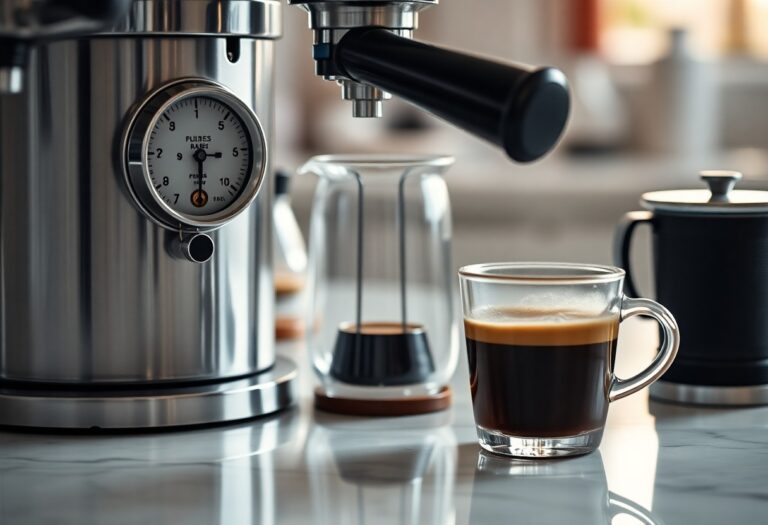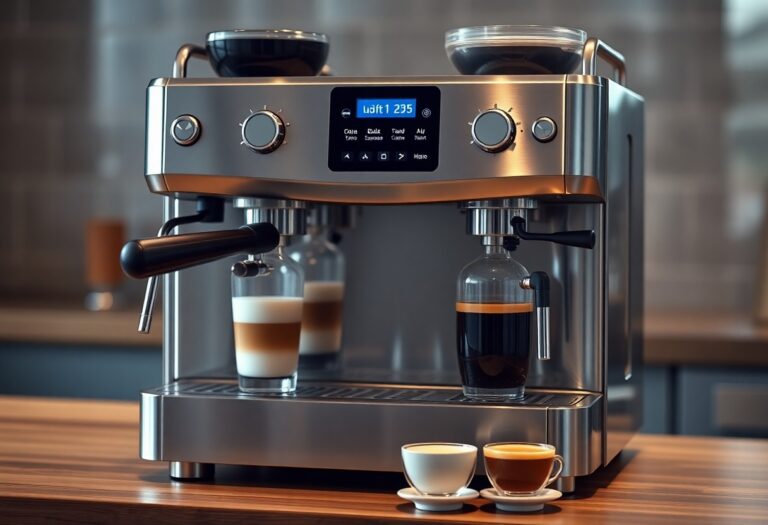What Coffee Beans to Use in an Espresso Machine – Bean Selection
It’s important to choose the right coffee beans for your espresso machine to achieve the best flavor and aroma. Look for beans that are specifically labeled for espresso, as they are often roasted to enhance the rich, bold characteristics you desire. Freshness is key—aim to use beans that have been roasted within the last month for optimal taste. Additionally, consider the roast level; medium to dark roasts typically work best, offering a balanced flavor profile that complements espresso’s intensity. By selecting high-quality beans, you can significantly elevate your espresso experience.
Key Takeaways:
- Choose Arabica beans for a sweeter and more nuanced flavor profile, while Robusta beans offer a stronger and bolder taste with added crema.
- Look for freshly roasted coffee beans, ideally within a few weeks of roasting, to ensure the best flavor and aroma in your espresso.
- Experiment with different roast levels—light, medium, and dark—to find the one that suits your personal taste preferences for espresso.
- Consider blends designed specifically for espresso, as they often combine multiple bean types to create a balanced and rich flavor.
- Pay attention to the grind size; finer grinds typically produce a better extraction for espresso, enhancing the overall experience.
The Flavor Symphony: Understanding Coffee Bean Varietals
The complexities of coffee flavor come alive when you explore the different bean varietals available. Each type carries unique characteristics, influenced by its genetic profile, growing conditions, and processing methods. While many espresso enthusiasts gravitate towards specific blends, understanding the subtleties of each varietal can enhance your cup significantly. You can research deeper into The Differences Between Coffee Beans and Espresso to see how these distinctions play out in brewing.
Arabica vs. Robusta: The Great Debate
Arabica and Robusta are the two main coffee varietals you’ll encounter. Arabica beans tend to provide a smoother, sweeter flavor with hints of fruit and sugar, making them the preferred choice for many espresso aficionados. On the other hand, Robusta is typically stronger with a more bitter, earthy profile, often favored for its higher caffeine content and creamy body. Understanding these differences will help you select the perfect beans for your espresso machine.
The Role of Origin: Terroir and Its Impact
Every coffee bean’s flavor is profoundly influenced by its origin. Terroir refers to the environmental conditions where the coffee is grown, including soil type, altitude, climate, and even local farming practices. For instance, beans grown at high altitudes usually develop a more complex flavor profile, with brighter acidity and distinctive notes. This is why beans from regions like Ethiopia are celebrated for their floral and fruity qualities, while those from Brazil often exhibit chocolatey and nutty characteristics.
Understanding the significance of terroir in coffee can unlock new flavor dimensions in your espresso. For example, beans cultivated in volcanic soil may possess a richer mineral content, enhancing their taste profile compared to beans from more arid regions. Experimenting with single-origin beans allows you to experience these unique flavors firsthand, revealing how a bean’s place of growth shapes its character. By selecting beans with distinct terroir, you can truly elevate your espresso experience, making each cup uniquely flavorful.

Roast Profile Perfection: Matching Beans with Machine
Finding the ideal roast profile for your espresso machine is necessary in achieving that perfect shot. Different roasting levels unlock distinct flavors and aromas, allowing you to customize your coffee experience based on your taste preferences and the specificities of the machine you are using. Factors such as brewing temperature and pressure can influence how well the roast enhances the coffee’s natural attributes, leading to an optimized espresso each time you brew.
Light, Medium, or Dark: Finding the Sweet Spot
Your choice of roast—light, medium, or dark—directly impacts the espresso’s taste. Light roasts typically highlight fruity and floral notes, providing clarity and brightness. Medium roasts strike a balance between acidity and body, while dark roasts bring forth deep, rich flavors often associated with chocolate and caramel. Experimenting with different profiles can lead you to your perfect espresso blend, depending on your palate.
The Science of Brewing Temperature and Extraction
The relationship between brewing temperature and extraction is fundamental in achieving a balanced cup. Generally, espresso is brewed between 90-96°C (194-205°F). Too high a temperature can lead to over-extraction, resulting in bitterness, while too low can cause under-extraction, leading to sourness. Each roast level reacts differently under these temperatures, greatly influencing the final flavor profile.
Understanding Temperature and Extraction
| Temperature Range | Impact on Extraction |
|---|---|
| Less than 90°C (194°F) | Under-extraction, sour and weak flavors |
| 90-96°C (194-205°F) | Optimal extraction, balanced flavors |
| Above 96°C (205°F) | Over-extraction, bitter and harsh flavors |
Paying close attention to these extraction nuances can enhance your espresso experience significantly. If you favor a fruity light roast, brewing on the lower end of the spectrum will accentuate those delicate flavors, while a robust dark roast can benefit from slightly higher temperatures, deepening its rich, bold characteristics. Fine-tuning your brew’s temperature allows for greater control over flavor extraction, giving your espresso a beautifully balanced profile.
Grind Matters: The Key to Espresso Extraction
Achieving the perfect espresso involves paying close attention to your grind size. The grind affects not only the extraction time but also how flavors are expressed in your cup. A finer grind increases the surface area, leading to quicker extraction and a more intense flavor profile. Conversely, a coarser grind results in a milder taste, as it slows down the extraction process. You’ll need to experiment with your specific beans and machine to dial in that sweet spot for optimal results.
Coarse vs. Fine: Tailoring Grind Size for Optimal Results
The choice between coarse and fine grind boils down to balancing extraction time and flavor strength. A fine grind extracts flavors rapidly, making it ideal for the high-pressure environment of an espresso machine. However, if the grind is too fine, it may lead to over-extraction and bitter notes. On the other hand, a coarse grind will slow the extraction, risking under-extraction and a lack of vibrant flavors. Adjusting the grind size based on your beans will help you achieve a well-rounded espresso.
Freshness Counts: The Importance of Grinding Just Before Brewing
Grinding your coffee beans immediately before brewing maximizes flavor retention and overall quality. Coffee beans begin to lose their flavor within minutes of grinding due to exposure to oxygen, heat, and light. Freshly ground coffee maintains its crucial oils and volatile compounds, providing a richer and more aromatic espresso experience. Aim to grind just enough for your immediate use, ensuring each shot bursts with freshness and vibrant flavors.
Grinding just before brewing is particularly significant for espresso, as the high-pressure extraction requires optimal freshness for a balanced shot. Consider investing in a quality burr grinder, which offers consistent particle size and preserves the integrity of your beans. For espresso, aiming for a grind size that resembles table salt can provide a nuanced flavor profile, bringing out the best characteristics of your chosen beans. This dedication to freshness and precision in your grind will elevate your espresso experience considerably.

Blends vs. Single Origins: The Choice That Defines Your Espresso
Your choice between blends and single origin beans can dramatically influence the flavor profile of your espresso. Blends often combine various beans from different regions to create a balanced flavor, while single origin beans showcase the unique attributes of a specific locale. The decision shapes not just the taste but also the overall experience of your espresso, resulting in distinct journeys through your cup. Both options have passionate advocates, so it’s vital to explore the nuances that make each appealing.
Advantages of Blends: Complexity and Consistency
Blends provide complexity and consistency, making them a favorite among many espresso enthusiasts. By combining beans from various sources, roasters can create a harmonious balance that highlights the best characteristics of each bean involved. This meticulous crafting often leads to a dependable flavor profile that maintains its quality across multiple batches, which is vital for cafés and home drinkers alike seeking a reliable cup at every brew.
The Allure of Single Origins: A Journey Through Unique Flavors
Single origin beans offer a tapestry of flavors, each cup presenting a unique story linked to its geographical origin. Sourcing beans from a specific region allows you to savor distinctive tasting notes such as fruity, floral, or earthy characteristics that define that area. For example, Ethiopian Yirgacheffe may reveal notes of jasmine and blueberry, while a Sumatra coffee might bring rustic, earthy tones to your espresso. This adventure through diverse flavor profiles makes exploring single origins a sensory delight.
Delving into single origin coffees means experiencing one-of-a-kind flavors that stem from the unique growing conditions, processing methods, and regional terroirs. For instance, beans from Central America often bring bright acidity and citrus notes, while beans from South America might showcase chocolate and nuttiness. You might find a Kenyan coffee that excites your palate with its vibrant acidity and berry undertones. By sourcing beans individually, you’re able to appreciate and celebrate the characteristics specific to their origins, allowing your espresso to tell a fascinating, flavorful narrative with every sip.
Navigating Sustainability: Ethical Bean Sourcing
Sourcing coffee beans with sustainability in mind not only benefits the planet but also enriches the taste of your espresso. By choosing beans from reputable farms that prioritize both environmental stewardship and fair treatment of workers, you ensure that your coffee supports sustainable practices. Engaging with your coffee’s origin cultivates awareness about how ethical farming contributes to better quality beans, making your espresso experience even more satisfying.
Understanding Certifications: Fair Trade, Organic, and Beyond
Familiarizing yourself with certifications such as Fair Trade and Organic can greatly enhance your bean selection process. Fair Trade ensures that farmers receive equitable compensation and adhere to ethical labor practices, while organic certifications signify that the coffee was grown without harmful chemicals. Exploring additional certifications, like Rainforest Alliance and Direct Trade, further qualifies the sustainability of your coffee choices.
The Impact of Sustainability on Flavor and Quality
Sustainably sourced coffee beans often exhibit superior flavor profiles and enhanced quality in your espresso. Beans grown with sustainable practices tend to enjoy richer soil and healthier ecosystems, resulting in higher-quality crops. Moreover, farmers committed to sustainable methods utilize better harvesting and processing techniques, which directly translate to a more vibrant cup. Varietals from certified farms can also naturally express their unique characteristics, leading to a more complex and enjoyable espresso.
The relationship between sustainability and flavor should not be underestimated. For instance, a study from the Specialty Coffee Association indicates that eco-friendly farming practices often lead to beans with higher acidity and nuanced sweetness, enhancing the overall espresso experience. When coffee is cultivated without synthetic fertilizers or pesticides, the plants thrive, producing beans that not only taste better but have a compelling backstory that enriches your appreciation. Consequently, by supporting sustainable farming, you’re not just drinking coffee; you’re savoring a more ethical and flavorful journey from farm to cup.
To wrap up
On the whole, selecting the right coffee beans for your espresso machine can significantly enhance your brewing experience. You should consider using high-quality, freshly roasted beans with a flavor profile that matches your preferences. Single-origin or blends can both make delightful espresso, but experimenting with different types will help you discover what suits your taste best. Ultimately, it’s about finding the perfect beans that resonate with your palate and elevate your daily coffee ritual.
FAQ
Q: What type of coffee bean is best for making espresso?
A: The best type of coffee bean for espresso is typically a dark roast, which enhances the rich, bold flavors desired in espresso. However, many baristas also enjoy medium roast beans for their balanced flavor profile. Beans from Arabica or Robusta species can be used, with Arabica being preferred for its sweetness and complexity, while Robusta offers higher caffeine content and a thicker crema.
Q: Should I use single-origin beans or blends for espresso?
A: Both single-origin beans and blends can be excellent choices for espresso. Single-origin beans often provide unique flavor notes and characteristics from a specific region, making for an interesting shot of espresso. On the other hand, blends are crafted to achieve a well-rounded flavor profile, often enhancing the crema and body of the espresso. The choice depends on personal preference and desired flavor experience.
Q: How fresh should my coffee beans be for espresso?
A: Freshness is a key factor in the quality of espresso. Ideally, coffee beans should be used within 2-4 weeks of their roast date to capture the optimal flavors and aromas. Purchasing beans from a local roaster can ensure freshness. Always store your beans in an airtight container away from light, heat, and moisture to maintain their freshness for as long as possible.
Q: Can I use flavored coffee beans for espresso?
A: While it’s possible to use flavored coffee beans for espresso, it is generally not recommended if you want to savor the traditional taste of espresso. The added flavors can mask the natural profiles of the coffee and may not extract well under high pressure. If you enjoy flavored coffee, consider using them in a regular coffee brew or in a milk-based espresso drink where the flavors can complement other ingredients.
Q: What grind size should I use for espresso beans?
A: For espresso, the grind size is typically very fine, similar to that of granulated sugar. This allows for optimal extraction during the brewing process, creating a rich and creamy shot of espresso. It’s important to adjust the grind size based on your espresso machine and personal taste preferences, as factors such as brewing time and pressure can influence the ideal grind for your setup.







